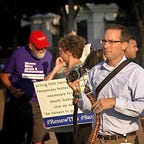Look back on your childhood and I’m willing to bet something saved you. Maybe it was a teacher, faith leader or friend who believed in you. Maybe it was a science project or book that inspired you. For me it was a bike. A bike that just last week came back into my life and into the arms of my daughter.
Growing up, I loved riding bikes. My parents, while imperfect, got one thing right. They knew the value that came with a kid on a bike. It was the 1970's and my banana seat bike took me seemingly everywhere: the 5-and-dime store for candy in suburban Philadelphia, the woods of rural Ohio to explore and finally past the forever fields of corn and fresh strawberries of Indiana. Anywhere two wheels would take us, me and my friends would go.
In the early 1980’s I begged for and got my first “real” bike. It was a Nishiki touring bike. I couldn’t believe my luck. I started following the Tour de France soon-there-after in 1983. That’s when we moved to Indiana.
In 1984 something beyond imagination unfolded in Europe. American Greg Lemond finished 3rd overall in the Tour to Bernard Hinault and Lauren Fignon. The next year, Lemond finished second. The following year he won. Lemond vaulted to stardom and inspired young riders across the country.
So desperately searching for an identity, I decided at 15 that I was going to be a cyclist. I read everything I could about the sport, started training and even jumped into a few local races. Keep in mind, these races were not fancy affairs. They were called Citizen’s Races. Everyone would line up at the starting line together: kids with streamers flowing from handlebars, adults on clunky old Schwinns and me atop my Nishiki. I was average. Just good enough to not quit, mediocre enough to stay humble.
Life at home would deteriorate considerably when I turned 16. A troubled, abusive step-father made being in the house a challenge. It’s no surprise I spent a lot of time on my bike that year and for many years to come. I rode so much that I got better. A lot better. I started winning.
I begged my parents for an upgrade. I was intrigued by Cannondale: a company that revolutionize the manufacture of bikes in 1983. Cannondale’s over-sized aluminum tubes provided stunning stiffness. I fancied myself a sprinter. A stiff, responsive bike was exactly what I needed.
While I loved the bike, my competitors didn’t. It was new and strange and different. A lot of people don’t like new and strange and different. Cyclists can be horribly judgmental. Other riders literally made fun of my bike, my cheap parts and my over-sized helmet not to mention my second-hand Team USA gloves. Their cattiness only fueled me.
But getting the Cannondale was a battle. Guilt was something my frugal Jewish mother delivered with remarkable precision and all the subtly of a cartoon anvil. I could get it she said, but at a literal cost. In exchange for the bike I would receive no gifts of any kind for the next year. They got me the cheapest model. It was blue. $395 dollars. My step-father couldn’t understand why a scrawny, stupid, back-chatting punk like myself deserved anything nice, let alone a new bike. But I agreed to no more gifts that year. In fact, I told my mother she didn’t need to give me anything else the rest of my life. Just get me that bike.
My mom didn’t realize that I would have traded just about anything for a real racing bike at that time. Because I knew, even as an immature 16-year-old, that that bike was my Willy Wonka Golden Ticket and I was Charlie Bucket. That bike was my way out. In the darkest of hours, I often thought about packing a bag, slipping out of the driveway early one morning and never looking back. Ever. In my mind, I knew no one would miss me.
In the coming years, riding atop that Cannondale gave me the confidence I needed to take on the world. It made me strong and fast and full of purpose and hope. Sport, if nothing else, teaches you planning and perseverance. I realized, if I could win on the bike, maybe I could figure life out. Maybe.
In college, I moved up the ranks of cycling. I was a good regional rider. I won races, even a state championship that neither parent attended. Yes, I was alone. But I was no longer lonely. I still ride. I still race. And last weekend life came full circle.
My daughter said she wouldn’t mind a retro road bike for her 15th birthday. So, we went to the annual used bike swap held in Washington DC. She tried a couple bikes then suddenly we saw it. In a dark space in the corner of the warehouse there it was: a delightful sparkly green Cannondale with gorgeous white handlebar tape. She loved it. She took it for a test ride. It fit perfectly.
As it would turn out, the nice folks at The Old Bike Shop in Arlington loved the story about my connection to this old Cannondale. They did some research while giving the bike a final tune-up and found that it was from 1986, the year after I got my Cannondale. It was the upgraded version.
So, my daughter’s bike was nicer than the one that gave me immeasurable purpose. I told her this. She liked the old story and asked what I did with my old blue Cannondale. I told her I sold it about 20 years ago for $25 at a garage sale. She wondered if that was something I regretted.
I let the bike go because it did its job. It saved me. Maybe it would save someone else.
